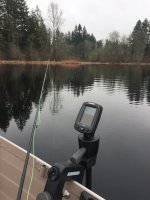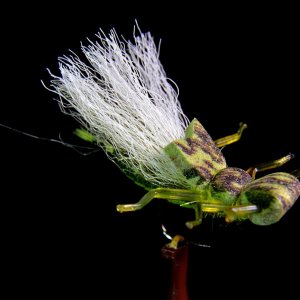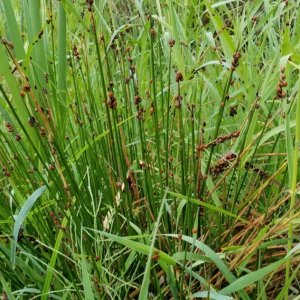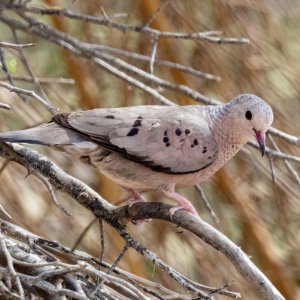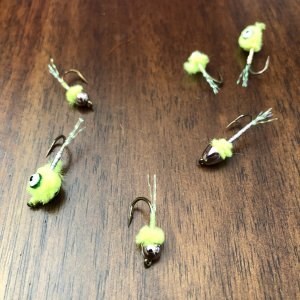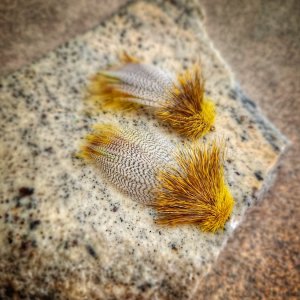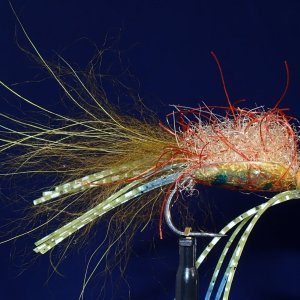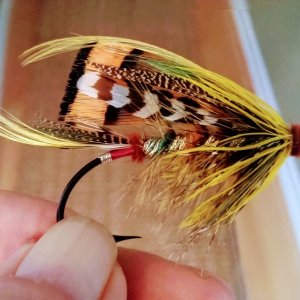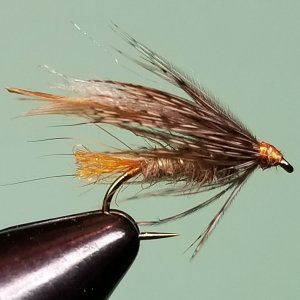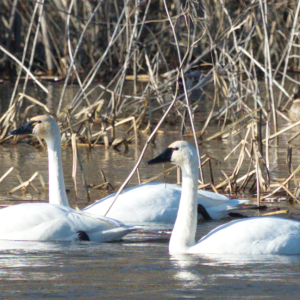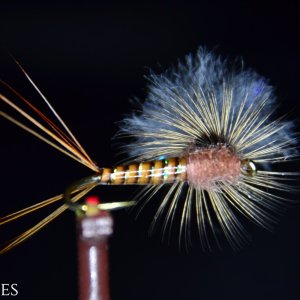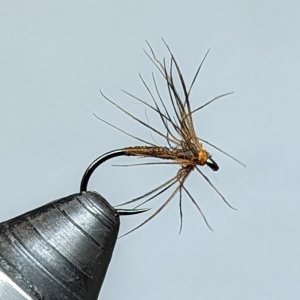How do you approach fishing deep under the indi with small flies? Say you want to present two different colors of small chironomids, deeper than 10 feet or so. Or, a small chironomid and a bloodworm pattern. None of these flies sink all that quickly. How do you approach fishing deep this way with small flies under the indicator? Are you just more patient than I, tie on two small flies, adjust indi depth and wait until they sink? I'm not confident that tiny flies are where I want them when I fish deeper than say ten feet and there's nothing else to drag them down. I like using a mini leech with its heavier bead to get small flies down, but what if I am not sure what color small fly to try? I stopped using swivels for this a while back because I got tired of fish eating the swivel and setting up on nothing.
You are using an out of date browser. It may not display this or other websites correctly.
You should upgrade or use an alternative browser.
You should upgrade or use an alternative browser.
Stillwater indicator watchers: What's your approach?
- Thread starter Matt B
- Start date
Sometimes I'll put a level leech with some weight on the bottom of the rig, or some other heavier nymph. You could always use a swivel above the flies, if you absolutely want a little bloodworm on the bottom. The other thing you can do is pre-rig a bunch of two or three fly combos on those tubes or a piece of pipe insulation. Makes finding the right color a little easier. I've gotten some good advice to try different depths before changing flies, since they're not always right on the bottom.
Thanks--my standard m.o. is starting deep, close to bottom, and then move up a couple-few feet at a time.Sometimes I'll put a level leech with some weight on the bottom of the rig, or some other heavier nymph. You could always use a swivel above the flies, if you absolutely want a little bloodworm on the bottom. The other thing you can do is pre-rig a bunch of two or three fly combos on those tubes or a piece of pipe insulation. Makes finding the right color a little easier. I've gotten some good advice to try different depths before changing flies, since they're not always right on the bottom.
Not a fan a swivels in my stillwater rigs anymore. Sometimes fish eat those things, and my swivels don't have hooks, so it's just another variable I want to eliminate if at all possible.
Haha, so you go with two small flies and a heap o' patience/liquid distraction?I think the difference is a 16 oz vs a standard 12 oz beer.
after a while I find my set reaction is a bit slower with the deeper method though
Sure, it's all relative right? I use that as a threshold between, need to "rig up" with a QR indi and long straight leader, or possible to really just use a thingamabob and a tapered leader with some extra tippet, know what I mean? And I would fish two small bead heads with nothing else up to 10' or so and feel like they were more or less as deep as I needed them, hanging straight.Also, 10’ is not deep. Deepest I’ve fished under an indicator is around 32’.
I go up to about 20-22 if I have to, but I don't like it. 16-18 is friendlier. Lotta 20' depths out there.
troutpocket
Stillwater strategist
I’m not too worried about a pair of smaller flies getting down until we’re talking about 20+ feet. Up to that point, as long as one pattern has a tungsten bead, I have confidence that I’m getting down. Might take a minute. But sometimes I catch fish on the drop.
Deeper than 20’ I’m using a full sink line hanging vertically…or using the “tool fly” approach with a larger pattern/big tungsten bead to make sure the smaller fly is getting down quickly.
Deeper than 20’ I’m using a full sink line hanging vertically…or using the “tool fly” approach with a larger pattern/big tungsten bead to make sure the smaller fly is getting down quickly.
PBR tall boys!I think the difference is a 16 oz vs a standard 12 oz beer.
after a while I find my set reaction is a bit slower with the deeper method though
I regularly fish unweighted bloodworm patterns and have not problem reaching the bottom (at least to 15 feet) which this time of year is as deep as I fish. Later in the year I fish 20+ deep and then I fish at least one fly with a tungsten bead and have no problems of reaching the bottom (have tested both by leaving a couple feet of extra depth and consistent catch bottom "gunk". With the unweighted flies and good fishing breeze I'll fish straight downwind to avoid a bobber swing/drift.
Good Luck
Curt
Good Luck
Curt
Like sex in a canoe...coors light actually - but lets not further rob this thread
I’m not too worried about a pair of smaller flies getting down until we’re talking about 20+ feet. Up to that point, as long as one pattern has a tungsten bead, I have confidence that I’m getting down. Might take a minute. But sometimes I catch fish on the drop.
Deeper than 20’ I’m using a full sink line hanging vertically…or using the “tool fly” approach with a larger pattern/big tungsten bead to make sure the smaller fly is getting down quickly.
Thanks, you are helping increase my confidence that my flies are able to get down there where I want them. Sounds like tungsten beads are the ticket. Trouble now is I have a ton of chironomids at this point where I am not sure if the bead is tungsten or not! But, if @Smalma gets an unweighted bloodworm down, I guess that shouldn't be a problem. Curt, is that just something like red thread on a hook, tied to something like 4x or 5x fluoro under an indicator with floating line? That gets down 15 feet? Just confirming. Because, you know, it's hard to see that deep. I want to know my stuff is down there!I regularly fish unweighted bloodworm patterns and have not problem reaching the bottom (at least to 15 feet) which this time of year is as deep as I fish. Later in the year I fish 20+ deep and then I fish at least one fly with a tungsten bead and have no problems of reaching the bottom (have tested both by leaving a couple feet of extra depth and consistent catch bottom "gunk". With the unweighted flies and good fishing breeze I'll fish straight downwind to avoid a bobber swing/drift.
Good Luck
Curt
I hardly ever leave it there untouched for 3 minutes. If it's not already doing something in the waves and wind, I'm twitching it, or finger twisting, or sometimes foot-long pulls draw strikes. I can't just let it sit there untouched and stare at it, even though I know that's a very legit presentation.I don't have any patience to watch a bobber/indicator even 3 minutes. So I don't to it.
Split shot. I've pretty much switched to tungsten beads, but I have a lot of midges with brass beads and some with glass beads. Here in WA in FF only waters, split shot is illegal but I rarely fish FF only water (that's another story for another day). When my midges are small, a small split shot on the leader helps get the rigging down. Let us not forget fuse wire wrapped on the shank of the hook. Then of course, TMC 2457 V 2487; the former will sink a fly pretty quickly (I can't remember the last time I tied a midge on a 2457).Thanks, you are helping increase my confidence that my flies are able to get down there where I want them. Sounds like tungsten beads are the ticket. Trouble now is I have a ton of chironomids at this point where I am not sure if the bead is tungsten or not! But, if @Smalma gets an unweighted bloodworm down, I guess that shouldn't be a problem. Curt, is that just something like red thread on a hook, tied to something like 4x or 5x fluoro under an indicator with floating line? That gets down 15 feet? Just confirming. Because, you know, it's hard to see that deep. I want to know my stuff is down there!

